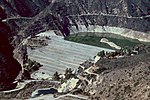San Gabriel Mountains National Monument

The San Gabriel Mountains National Monument is a United States National Monument managed by the U.S. Forest Service, which encompasses parts of the Angeles National Forest and the San Bernardino National Forest in California. On October 10, 2014, President Barack Obama used his authority under the Antiquities Act to create the new monument, protecting 346,177 acres of public lands in the San Gabriel Mountains of the Transverse Ranges. The effort to protect the San Gabriel Mountains began more than a century earlier, in 1891 with another U.S. President, Benjamin Harrison, the 23rd president, using a congressional act, to designate and delineate the first federal protection in the United States of forested lands, using the same mountain range name, as the San Gabriel Timberland Reserve. Two earlier California conservationists, Abbot Kinney and John Muir, influenced President Benjamin Harrison.
Excerpt from the Wikipedia article San Gabriel Mountains National Monument (License: CC BY-SA 3.0, Authors, Images).San Gabriel Mountains National Monument
Geographical coordinates (GPS) Address Nearby Places Show on map
Geographical coordinates (GPS)
| Latitude | Longitude |
|---|---|
| N 34.25 ° | E -117.83888888889 ° |
Address
California, United States
Open on Google Maps








